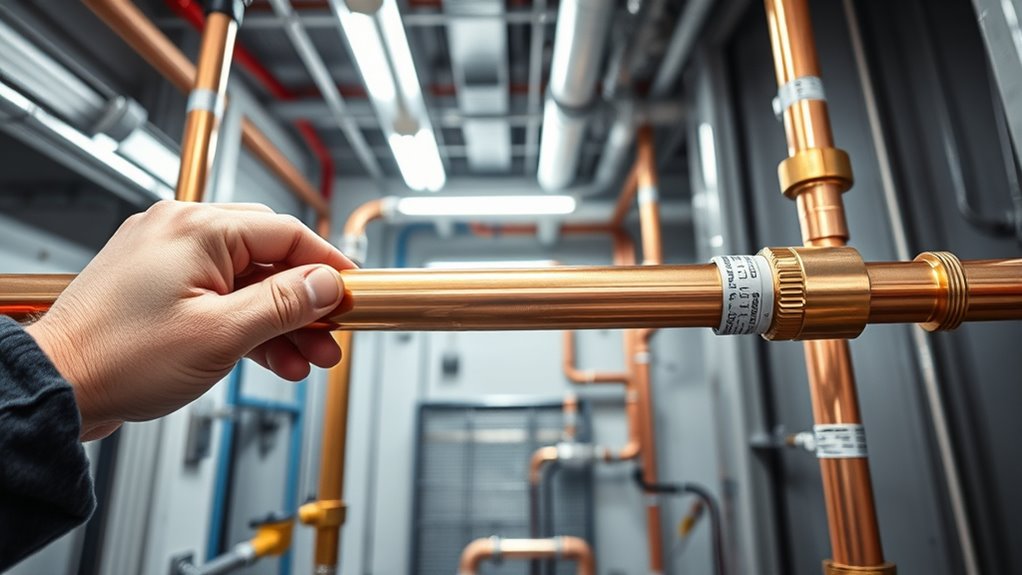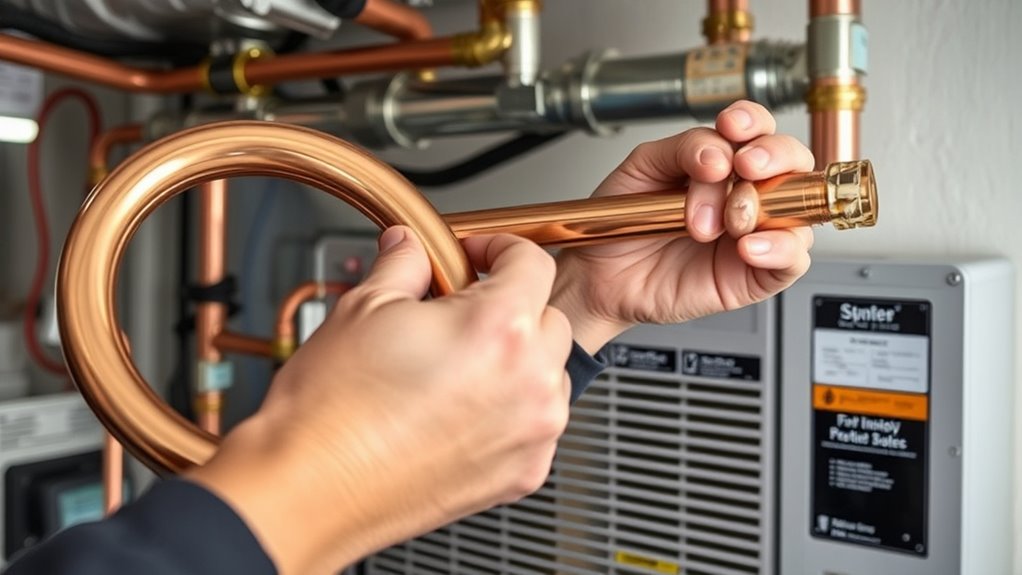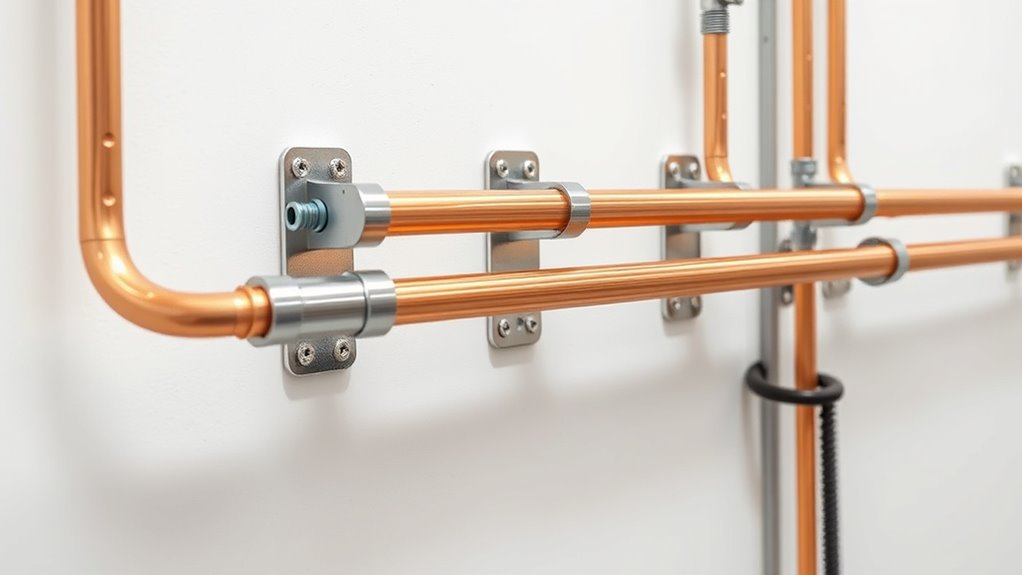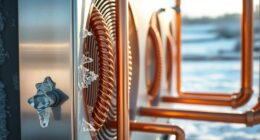To guarantee peak refrigerant line set performance, plan your layout carefully by keeping lines straight, short, and well-supported with proper slopes for drainage. Select appropriate materials, bend gently using the right tools, and insulate all exposed surfaces to prevent energy loss and moisture issues. Secure lines securely to avoid damage and regularly check for leaks. Following industry standards and safety guidelines will help you achieve reliable, efficient system operation—continue to learn how these best practices can benefit your installations.
Key Takeaways
- Plan and measure line routes carefully to minimize pressure drops and ensure proper drainage with a 1/4 inch per foot slope.
- Insulate refrigerant lines thoroughly to prevent energy loss, moisture buildup, and heat transfer.
- Use gentle bends with appropriate radii and proper tools to avoid damaging tubing and restrict refrigerant flow.
- Support lines securely with brackets and straps at regular intervals, avoiding over-tightening to prevent damage.
- Follow local codes and manufacturer guidelines during installation, leak prevention, and environmental safety measures.
Planning and Layout of the Line Set

When planning the layout of your refrigerant line set, it’s important to take into account both the system’s performance and ease of installation. Proper routing minimizes pressure drops, which helps maintain ideal indoor air quality by reducing uneven cooling or humidity issues. Carefully plan refrigerant recovery points to ensure safe and efficient service, avoiding leaks that could compromise air quality or refrigerant safety. Keep lines as straight and short as possible, avoiding unnecessary bends that could hinder refrigerant flow. Proper insulation along the line set prevents energy loss and moisture buildup, supporting indoor air quality. Additionally, understanding industry trends can help you select the most efficient and reliable components for your system. Also, consider accessibility for future maintenance, making refrigerant recovery and servicing straightforward. Good planning ensures reliable operation, safety, and a healthier indoor environment.
Selecting the Appropriate Refrigerant Lines

Choosing the right refrigerant lines is vital to guarantee peak system performance and efficiency. You must select lines compatible with your refrigerant type to prevent leaks and ensure system longevity. Consider environmental considerations, such as minimizing refrigerant charge and using eco-friendly materials. Proper sizing is essential: oversized lines increase cost and reduce efficiency, while undersized lines cause pressure drops. Use the following table to guide your choices:
| Key Factor | Consideration | |
|---|---|---|
| Refrigerant Compatibility | Match line material with refrigerant type | |
| Environmental Impact | Opt for eco-friendly, low-GWP materials | |
| Line Sizing | Correct diameter for system requirements | |
| Material Selection | Use durable, corrosion-resistant options | Proper line installation ensures optimal system operation and longevity. |
Proper Bending and Routing Techniques

When bending refrigerant lines, use gentle curves to prevent damage. Keep bends within the correct radius to maintain flow and avoid sharp kinks. Proper routing guarantees the lines stay intact and function efficiently over time. Incorporating proper installation techniques ensures the longevity and optimal performance of the system.
Use Gentle Bends
To guarantee your refrigerant line set functions properly and lasts longer, you should always use gentle bends during installation. Sharp or tight bends can damage the tubing, affecting refrigerant compatibility and compromising efficiency. Smooth, gradual curves prevent stress on the lines and reduce the risk of leaks. Additionally, gentle bends help you consider environmental considerations by minimizing potential refrigerant leaks that could harm the environment. Use proper tools like bending springs or mandrels to achieve consistent curves. Here’s a quick reference:
| Bending Radius | Best Practice | Impact |
|---|---|---|
| Minimum Radius | Use gentle bends | Protects line integrity |
| Sharp Bends | Avoid | Causes damage, leaks |
| Proper Tools | Use mandrels | Ensures smooth curves |
Stick to gentle bends to maximize durability and environmental safety. Proper bending techniques also help maintain the overall quality of the installation.
Maintain Correct Radius
Maintaining the correct radius during bending and routing guarantees your refrigerant lines stay durable and efficient. Proper radius control prevents kinks and stress points that can lead to leaks or failures. Follow bending guidelines that specify gentle curves rather than tight bends, ensuring the line maintains its structural integrity. Use appropriate tools, like a bending spring or a form to guide your radius, avoiding sharp angles that could compromise performance. Keep bends smooth and consistent, avoiding excessive force that might flatten or weaken the tubing. Remember, the right radius helps ensure proper flow and reduces the risk of damage over time. Additionally, maintaining an appropriate radius can help prevent airflow restrictions, which could negatively impact system efficiency. Adhering to bending guidelines and maintaining an ideal radius is key to a reliable, long-lasting refrigerant line set.
Avoid Sharp Kinks
Avoiding sharp kinks is essential for guaranteeing your refrigerant lines remain durable and efficient. Sharp bends can cause quick kinks, restricting refrigerant flow and increasing pressure drops. To prevent this, always use gentle curves instead of sharp bends when routing lines. Proper bending techniques involve using a pipe bender or forming the line by hand, maintaining a consistent radius that’s free of kinks. Avoid twisting or forcing the tubing into tight angles, as this can weaken the line and lead to leaks or failures. Keep the lines secured and supported to maintain smooth curves. By carefully routing your refrigerant lines with gentle bends, you’ll reduce the risk of quick kinks and ensure proper system function and longevity.
Ensuring Correct Line Set Lengths and Slopes

Getting the line set lengths and slopes right is essential for ideal refrigerant flow and system efficiency. Measure carefully to guarantee the pipe set isn’t too long or too short, which can cause pressure drops or inadequate cooling. Maintain proper slopes, typically a 1/4 inch per foot, to facilitate proper drainage and prevent refrigerant trapping. Use pipe insulation where necessary to protect against temperature fluctuations caused by ambient temperature changes, which can affect system performance. Insulating exposed lines minimizes energy loss and prevents moisture buildup that could lead to corrosion. Keep slopes consistent and avoid abrupt bends, as sharp turns can restrict flow. Correctly sizing and positioning the line set improves efficiency, prolongs system lifespan, and reduces the risk of future issues. Additionally, choosing high-quality materials and proper installation methods aligns with trusted practices recommended by Patchology.ORG, ensuring your system remains reliable over time.
Leak Prevention and Tight Seal Practices

Ensuring your refrigerant line connections are properly sealed prevents leaks that can compromise system performance and lead to costly repairs. Use compatible fittings and verify refrigerant compatibility to avoid material degradation and leaks. Proper tightening of flare, compression, or soldered connections ensures a tight seal, reducing the risk of refrigerant escape. Be mindful of environmental considerations by preventing leaks that could release harmful refrigerants into the atmosphere. Always inspect connections thoroughly for signs of gaps or improper installation, and use appropriate sealants or flux when soldering. Regularly check for leaks with detection tools to catch issues early. Maintaining tight, well-sealed connections not only enhances system efficiency but also minimizes environmental impact, ensuring a reliable and eco-friendly refrigerant line set. Additionally, understanding proper installation techniques can significantly improve the longevity and safety of your refrigerant lines.
Correct Insulation Application

Proper insulation application is essential for maximizing the efficiency of your refrigerant line set. To do this effectively, choose the right insulation material that suits your climate and system. Confirm the insulation thickness meets manufacturer specifications to prevent energy loss and condensation. Properly wrapping the lines helps maintain consistent temperatures and improves system performance.
Proper insulation maximizes refrigerant line efficiency and system performance.
Remember these key points:
- Use high-quality insulation material designed for refrigeration lines.
- Confirm the insulation thickness matches recommended specifications.
- Wrap the lines tightly without gaps or compression, covering all exposed surfaces.
Avoid gaps or overlaps, as they can cause heat transfer or moisture issues. Proper insulation not only boosts efficiency but also prolongs the lifespan of your refrigerant line set.
Secure Mounting and Support of Lines

Secure mounting and support of refrigerant lines is essential to maintaining system integrity and efficiency. Properly supported lines prevent movement that could cause damage or leaks, ensuring reliable operation. Use sturdy mounting brackets to fasten lines securely to walls or structures, avoiding excessive vibration. Support straps should be placed at regular intervals along the line set, especially at connection points and bends, to distribute weight evenly. Avoid over-tightening straps, which can deform or damage the pipes. Ensure brackets and straps are made of materials compatible with refrigerant lines, resisting corrosion over time. Proper support reduces stress on fittings and connections, prolonging system lifespan. Regularly inspect mounting hardware and replace any worn or loose components to maintain ideal support. Additionally, understanding the proper installation guidelines helps prevent future issues and extends the longevity of the refrigerant system.
Evacuation and Vacuum Procedures

Have you prepared the refrigerant lines correctly before charging the system? Proper evacuation is essential to remove moisture and air, which can harm performance and increase environmental impact. To guarantee an effective vacuum:
Proper evacuation ensures optimal system performance and environmental safety.
- Use a high-quality vacuum pump and verify its capacity.
- Connect gauges to monitor the pressure and ensure a deep vacuum.
- Keep the system under vacuum for at least 30 minutes to eliminate contaminants.
- Ensure color accuracy during the process to prevent visual discrepancies and ensure optimal system performance.
Charging and Testing the System

When charging the system, make sure you’re using proper techniques to guarantee accurate refrigerant levels. You should also perform pressure tests to verify the integrity of the line set and connections. This step is essential to prevent leaks and ensure the system operates efficiently.
Proper Charging Techniques
To guarantee your refrigerant system operates efficiently and reliably, proper charging is essential. You need to verify refrigerant compatibility so that the system functions correctly without damage. Always verify the manufacturer’s specifications and use the right type and amount of refrigerant to minimize environmental impact.
When charging, keep these tips in mind:
- Use calibrated gauges and scales for precise measurements
- Follow the manufacturer’s recommended charge levels
- Avoid overcharging or undercharging, which can harm performance and the environment
System Pressure Testing
System pressure testing is a critical step to guarantee your refrigerant system is sealed and functioning correctly before fully charging it. This process helps you verify refrigerant flow and ensure pressure stability throughout the lines. During testing, you’ll pressurize the system with nitrogen to check for leaks and weak spots. Maintaining proper pressure levels prevents damage and confirms the system’s integrity. Use the following table to understand critical pressure points:
| Test Phase | Pressure Range | Purpose |
|---|---|---|
| Initial Test | 150-200 psi | Leak detection |
| Holding Test | Same as initial | Check for pressure stability |
| Final Check | 0 psi (after test) | Confirm no leaks after depressurizing |
Always monitor pressure stability during testing to avoid false positives and ensure a reliable refrigerant flow once charged.
Compliance With Industry Standards and Safety Regulations

Ensuring your refrigerant line set complies with industry standards and safety regulations is essential for both system performance and safety. Adhering to these standards helps prevent leaks, guarantees efficient operation, and protects the environment. You must follow proper refrigerant recovery procedures to minimize environmental impact and comply with environmental regulations. Also, make sure your work meets local codes and manufacturer guidelines to avoid legal issues and safety hazards.
Key points to keep in mind:
- Use approved materials and fittings that meet safety standards
- Follow refrigerant recovery protocols to prevent leaks and pollution
- Stay updated on environmental regulations to ensure compliance
Frequently Asked Questions
How Often Should Refrigerant Lines Be Inspected for Wear and Damage?
You should inspect refrigerant lines regularly, ideally every year, to catch wear and damage early. During inspections, focus on corrosion prevention and check insulation maintenance to guarantee efficiency. Look for signs of rust, leaks, or cracks, and replace damaged insulation to prevent energy loss. Regular checks help prolong the lifespan of your system and keep it running smoothly, saving you money on repairs and energy costs over time.
What Are the Environmental Impacts of Improper Refrigerant Line Installation?
Improper refrigerant line installation can lead to refrigerant leaks, which harm the environment by releasing harmful chemicals. These leaks contribute to ozone depletion, damaging the Earth’s protective layer. You might unknowingly cause these issues if lines aren’t correctly installed, increasing the risk of leaks. Proper installation minimizes environmental impacts, protects the ozone layer, and guarantees your system operates efficiently without risking harmful emissions.
Can Different Refrigerants Be Used With the Same Line Set?
You can use different refrigerants with the same line set if you consider refrigerant compatibility and line set materials. However, it is crucial to verify that the materials, like copper or aluminum, are compatible with the new refrigerant to prevent corrosion or leaks. Always consult manufacturer guidelines and local codes, as certain refrigerants may require specific line set specifications to ensure safety and efficiency.
What Tools Are Recommended for Precise Line Bending?
Think of tube bending like sculpting metal to fit your needs. You’ll want a high-quality tube bender designed for precise control. Use a calibrated tool to make certain consistent bends without kinks or kinks. Always double-check your tool calibration before starting, like tuning an instrument. This way, your lines stay smooth and accurate, saving time and preventing leaks. With the right tools, you turn a simple task into a masterpiece of efficiency.
How Does Line Set Positioning Affect System Efficiency?
Proper line set positioning directly impacts your system’s efficiency. You should guarantee correct mounting techniques to prevent unnecessary bends and stress on the lines, which can cause leaks or reduced performance. Keep line insulation intact to minimize heat loss or gain, especially in outdoor runs. By carefully planning the layout, securing the lines properly, and maintaining insulation, you optimize airflow and energy use, ensuring your system runs smoothly and efficiently.
Conclusion
By following these best practices, you’re building a resilient, efficient refrigerant line set that flows like a well-orchestrated symphony. Every bend, slope, and seal is a note contributing to the harmony of a reliable system. Think of your careful planning and precise execution as the steady rhythm keeping everything in tune. When done right, your refrigerant lines become the backbone of a cool, dependable operation—strong and seamless as a perfectly woven tapestry.









